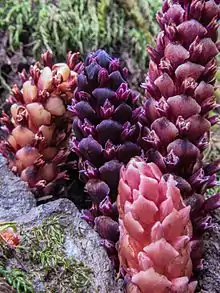| Vancouver groundcone | |
|---|---|
 | |
| Scientific classification | |
| Kingdom: | Plantae |
| Clade: | Tracheophytes |
| Clade: | Angiosperms |
| Clade: | Eudicots |
| Clade: | Asterids |
| Order: | Lamiales |
| Family: | Orobanchaceae |
| Genus: | Kopsiopsis |
| Species: | K. hookeri |
| Binomial name | |
| Kopsiopsis hookeri (Walp.) Govaerts | |
Kopsiopsis hookeri is a species of parasitic plant in the family Orobanchaceae known as Vancouver groundcone, small groundcone or poque.[1][2][3][4][5]
Distribution
It is native to western North America from British Columbia to northern California, where it grows in wooded areas.
Description
It is a parasite of salal bushes, which it parasitizes by penetrating them with haustoria to tap nutrients. The groundcone is visible aboveground as a purplish, brown, or yellowish cone-shaped inflorescence 3 to 6 cm (1.2 to 2.4 in) long. Pale-colored flowers emerge from between the overlapping bracts. Coastal aboriginal groups ate the potato-like stembase of Ground Cones raw, though usually as a snack and not in any quantity.[6]
Formerly considered Boschniakia hookeri, some taxonomists now place it in the genus Kopsiopsis on the basis of phylogenetic evidence.[2]
References
- ↑ "Kopsiopsis (Beck) Beck". Plants of the World Online. Royal Botanical Gardens Kew. Retrieved 29 August 2020.
- 1 2 Yu, Wen-Bin (2013-01-29). "Nomenclatural clarifications for names in Boschniakia, Kopsiopsis and Xylanche (Orobanchaceae)". Phytotaxa. 77 (3): 40–42. doi:10.11646/phytotaxa.77.3.1. ISSN 1179-3163.
- ↑ "The PLANTS Database". National Plant Data Team, Greensboro, NC USA. 2022. Retrieved 21 March 2022.
- ↑ Jepson Manual Treatment
- ↑ Nancy J. Turner (1995). Food plants of coastal First Peoples. Royal British Columbia Museum Handbook. UBC Press. ISBN 0-7748-0533-1.
- ↑ "Groundcone (Boschniakia SPP.)".